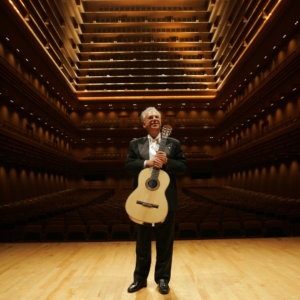Masterworks II
A Taste of Spain: Ravel, Revueltas & Rodrigo with guitarist Pepe Romero
November 3 & 4, 2023
Nov 3 – 7:30 pm, Maryland Hall
Nov 4 – 7:30 pm, Maryland Hall
CLICK HERE TO VIEW THE DIGITAL PROGRAM
Rossini Overture to Il barbiere di Siviglia (The Barber of Seville)
Rodrigo Fantasia para un Gentilhombre (Fantasia for a Gentleman) – Pepe Romero, guitar
Revueltas Homenaje a Federico García Lorca (Homage to Federico García Lorca)
Ravel Ma mère l’Oye (Mother Goose)
Masterworks II will be filled with Mediterranean flair, passionate music, and momentos sin respiración (moments of breathlessness). G. Rossini’s Overture to The Barber of Seville, the opening to that most famous comedic opera, uses masterful storytelling and music to bring to life the magic of Spain. It’s a wonderful way to begin this performance.
World-famous guitarist Pepe Romero brings Rodrigo’s Fantasia para un Gentilhombre (Fantasia for a Gentleman) to life. Romero is a living legend in the world of classical music. Honored by kings, heads of state, and major institutions, Romero’s most significant contribution to music is his affinity for connecting the richness and beauty of classical guitar to every audience.
Homenaje, which premiered in Madrid in 1937, is widely regarded as one of Revueltas’ most compelling works. It combines a highly personal and modernist approach juxtaposing folk, popular, and Indigenous musical elements. Revueltas used musical elements of folk, popular, and Indigenous music in his homage to the Spanish Civil War martyr, Federico García Lorca.
We move from Spain to southern France in a performance of Ravel’s Ma mère l’Oye (Mother Goose), a beautiful musical rendering of childhood fairy tales brought to life by Ravel, whose compositions were strongly influenced by his mother’s Basque-Spanish heritage. In 1911, Ravel re-wrote this piece for an extended ballet. This evening the ASO presents the complete ballet, including the original five-piece suite for orchestra.
Instrumentation
Gioacchino Rossini, The Barber of Seville Overture
Instrumentation: 2 flutes, 2 oboes, 2 clarinets, 2 bassoons, 2 horns, 2 trumpets, timpani, bass drum, and strings
As played by the London Symphony Orchestra:
https://www.youtube.com/watch?v=P0kJ4H_Nquw
Joquin Rodrigo, Fantasia Para un Gentilhombre
Instrumentation: Including the solo guitar, the concerto is scored for an orchestra consisting of a piccolo, a flute, an oboe, a bassoon, a trumpet in C, and strings.
As played by Pepe Romero:
Silvestre Revueltas, Homenaje a Frederico Garcia Lorca
Instrumentation: piccolo, E-flat clarinet, 2 trumpets, 1 trombone, 1 tuba, xylophone, 2 tam-tams, piano, violins, and double basses
As played by Orquesta de Càmara, conducted by Cesar Ivan Lara:
https://www.youtube.com/watch?v=MnRiaowABQM
Maurice Ravel, Ma Mère l’Oye
Instrumentation: 2 flutes (2nd doubling piccolo), 2 oboes (2nd doubling English horn), 2 clarinets, 2 bassoons (2nd doubling contrabassoon, 2 horns, timpani, bass drum, cymbals, side drum, triangle, tam-tam, xylophone, keyboard glockenspiel, suspended cymbal, harp, celeste, and strings
As played by Oslo Philharmonic, conducted by James Gaffigan:
https://www.youtube.com/watch?v=b4tMATIRHH0
Music Notes
In the early 19th century, opera overtures signaled to the audience that the entertainment was about to begin. Masterworks II presents Rossini’s Barber of Seville Overture as originally intended: an opening to an incredible performance! Masterworks II transports the audience to the Mediterranean as French, Italian, and Spanish composers inspire the audience to remember, recall, and recollect. Plus, the ASO is very excited to welcome Pepe Romero, world famous guitarist, to Annapolis.
Fantasía para un gentilhombre (Fantasia for a Gentleman) is a concerto for guitar and orchestra by the Spanish composer Joaquín Rodrigo. The music of Joaquin Rodrigo is steeped in the music and culture of his native Spain, including Baroque music of the early Spanish church as well as folk melodies and traditional Spanish folk instruments, especially the guitar. Born in Sagunto, Valencia, in 1901, Rodrigo was blinded at the age of three by diphtheria, which he said turned him early to a life of music. After winning early honors at the Conservatoire in Valencia, he studied in Paris with Paul Dukas at the École Normale de Musique, adding French influences to his style. He spent the Spanish Civil War exiled in Paris, but returned to Spain in 1939 and became the leading composer of his country. He is best known for his concerti, especially the haunting Concierto de Aranjuéz for guitar.
The four movements were based on six short dances for solo guitar by the 17th-century Spanish composer Gaspar Sanz and were taken from a three-volume work (1674, 1675, 1697) that is now commonly known as Instrucción de música sobre la guitarra española (Musical Instruction on the Spanish Guitar) (Donis 2005:75). Most of the movements retain the names that were originally given by Sanz.
The first movement, Villano y Ricercare, opens with the villano, a 17th-century dance with song popular in both Spain and Italy. The violins state the main theme and the flute elaborates, then the soloist leads the fugue of the ricare, while various sections of the ensemble follow. Throughout the interweaving of the fugal theme, the orchestration never overwhelms the flute–something we can attribute directly to Rodrigo, who was scoring for the equally delicate sound of guitar.
Españoleta y Fanfare de la Caballería de Nápoles combines the slow, lilting dance of the españoleta with a fanfare for, as the title states, the cavalry of Naples, which was under Spanish rule in Sanz’s time. The brisk fanfare includes a col legno section for the strings, where the players use the wooden side of the bow against the string.
The fast, rhythmic Danza de las Hachas is a “hatchet dance” meant to be performed with torches. Soloist and orchestra trade roles, each accompanying and then leading the dance.
The lively Canario is a folk dance from the Canary Islands in 6/8 time, in which orchestra and soloist compete in brilliant figures that grow in intensity until the flute breaks free in a virtuosic cadenza.
Rodrigo composed the concerto in 1954 at the request of the guitarist Andrés Segovia, who was evidently the gentilhombre referenced in the title. Segovia took the solo part at the premiere performance on March 5, 1958, in San Francisco.
 Pepe Romero will join the ASO for Ponce’s Concierto del Sur, one of the foremost guitar concertos of the repertoire. Pepe Romero is a living legend in the world of classical music. Honored by kings, heads of state, and major institutions, Romero’s most significant contribution to music is his affinity for connecting the richness and beauty of classical guitar to every audience. Romero has premiered works by the finest composers of the twentieth and twenty-first centuries and has long championed music by composers from earlier periods of musical history, including rare or lost pieces. Romero has recorded more than 60 works for guitar and vocal that are groundbreaking for the industry, making the sound and theory of classical guitar accessible to millions. Romero is the recipient of the “Premio Andalucía de la Música,” the highest recognition given by his native land for his contribution to the arts.
Pepe Romero will join the ASO for Ponce’s Concierto del Sur, one of the foremost guitar concertos of the repertoire. Pepe Romero is a living legend in the world of classical music. Honored by kings, heads of state, and major institutions, Romero’s most significant contribution to music is his affinity for connecting the richness and beauty of classical guitar to every audience. Romero has premiered works by the finest composers of the twentieth and twenty-first centuries and has long championed music by composers from earlier periods of musical history, including rare or lost pieces. Romero has recorded more than 60 works for guitar and vocal that are groundbreaking for the industry, making the sound and theory of classical guitar accessible to millions. Romero is the recipient of the “Premio Andalucía de la Música,” the highest recognition given by his native land for his contribution to the arts.
 On August 19, 1936, the Spanish poet Federico García Lorca was murdered by fascist militia forces at the onset of the Spanish Civil War. Outraged by the assassination, which may have been related to Lorca’s gay lifestyle or socialist leanings, Mexican composer Silvestre Revueltas was inspired to create his masterwork for chamber orchestra, Homenaje a Federico García Lorca (Tribute to Federico García Lorca). Revueltas’ Homenaje a Federico García Lorca premiered in Madrid in 1937, and remains widely regarded as one of his most compelling works, combining a highly personal and modernist approach by juxtaposing folk, popular, and Indigenous musical elements. Always attuned to the intersection of politics, art, and music, much of Revueltas’ work reflects a sense of nationalism and respect, if not even fondness, for his cultural traditions, often without quoting specific or well-known folk music outright. In this way, his creativity and artistry brought the melodies of Latin America to audiences around the world.
On August 19, 1936, the Spanish poet Federico García Lorca was murdered by fascist militia forces at the onset of the Spanish Civil War. Outraged by the assassination, which may have been related to Lorca’s gay lifestyle or socialist leanings, Mexican composer Silvestre Revueltas was inspired to create his masterwork for chamber orchestra, Homenaje a Federico García Lorca (Tribute to Federico García Lorca). Revueltas’ Homenaje a Federico García Lorca premiered in Madrid in 1937, and remains widely regarded as one of his most compelling works, combining a highly personal and modernist approach by juxtaposing folk, popular, and Indigenous musical elements. Always attuned to the intersection of politics, art, and music, much of Revueltas’ work reflects a sense of nationalism and respect, if not even fondness, for his cultural traditions, often without quoting specific or well-known folk music outright. In this way, his creativity and artistry brought the melodies of Latin America to audiences around the world.
FlexPass Subscribers get the most flexibility and best prices, as low as $27 per concert. Subscribe to a bundle of 3, 4 or 5 Masterworks concerts to save! Click here to subscribe!
Masterworks Subscribers! Please remember that your subscription entitles you to big savings on single tickets for companions! Sign into your account to purchase tickets now!
